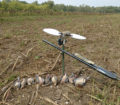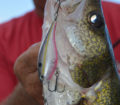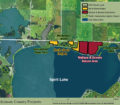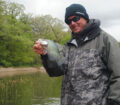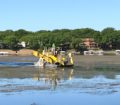By Jason Mitchell
Editor’s note: Jason Mitchell hosts the popular outdoor program Jason Mitchell Outdoors which airs on Fox Sports North on Sunday mornings at 9:00 am. More information can be found online at www.jasonmitchelloutdoors.com. Follow on YouTube, Facebook and Instagram.
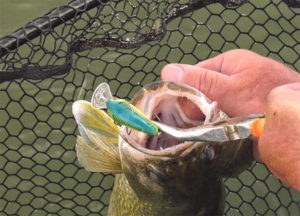
(photo submitted) Trolling high action lures like the Salmo Rattling 4.5 Hornet at high speeds is deadly come midsummer.
Crankbait trolling for walleye is so effective come mid-summer. Besides covering water, crankbaits also simply trigger fish. Most of the prominent trolling patterns in the Midwest are basin, contour or open water orientated. Trolling crankbaits is popular on big locations and shine for breaking down big water. Many people also associate crankbait trolling with deeper water especially come July and August.
So often the location dictates the presentation. Trolling takes room. As a rule, trolling crankbaits shines over big locations because if the location is small, you don’t stay in the zone very long. Trolling works to hunt down suspended fish. Trolling works to find scattered fish that are relating to a long contour. Trolling works to comb a basin. Trolling crankbaits can also work in more areas and work extremely well if you change your approach.
Many anglers think of trolling as incorporating multiple lines. In some cases, lead core and snap weights are used to get lures to a desired depth. Inline planer boards are used to spread out lines. Several rods are in rod holders and line-counter reels are a crucial piece of equipment. If there is one overlooked use for crankbaits however, that situation would be in much tighter locations. Small spots that most anglers will either pitch or run live bait through. In order to fish these locations however by trolling, you must get much faster and you can do that by scrapping a line-counter reel.
Even during the hottest periods of the summer, I catch nice walleye by running and gunning shallow locations that are windblown. Small rock points and fingers, weed lines and sometimes sand. The key so often is fishing through locations fast because these locations are either feast or famine. You might hit five spots without a scratch and then stack twenty fish in a short time on spot number six. But… you must speed things up.
Not talking trolling speed but rather the process. If you need time to deploy multiple rods behind the boat and need to wait for a line-counter to peel off line, that process is taking too long. With that equipment, you need to start fifty to a hundred yards away from the location to get lines out and ready. If the spot is only 50 yards long, you just wasted too much time. Expand your trolling this season by knowing when to troll with spinning rods. If you are less than twelve feet of water, you can get in the water much quicker with just a cast.
Over the last twenty years, anglers have become reliant on line-counters and dive curve charts. Crucial especially when over deeper water. For so many shallow locations however, trolling isn’t rocket science. If you bow hunt, you know the difference between ten and thirty yards. If you need to troll back at 30 feet in 10 feet of water, cast back 30 feet. By changing the equipment and getting confident in judging distance, you can up your trolling game because that is how you really speed up the process of getting in the water and fishing. You pull right up to the spot and it literally takes seconds to set up versus minutes.
When you dramatically speed up the deployment process, you can more quickly and efficiently fish much smaller locations. A 50-yard rock reef might not seem like a very good trolling spot but it sure can be when you can pull up to it and start fishing in seconds. When you get to the end, you don’t have to make a big turn to go back through (although I have caught a lot of fish off over no man’s land). Simply reel up and turn the boat sharp and cast right back out behind the boat. Because you can get in and out of the water so much faster with spinning rods versus line counter reels that weren’t designed to be casted, you can fish much more quickly through locations and hit locations that were traditionally fished with other presentations. These same basic principles also shine after dark or on river systems.
Whenever you can find walleye on shallow pieces of structure, this quicker trolling strategy shines. This strategy can also allow you to become much more aggressive when you are trying to hunt down fish. If you do have a three-hundred-yard trolling pass, there might be three or four sweet spots that are high percentage. Instead of trolling the entirety, you can hop into the sweet spots and cherry pick your best waypoints… really fast. If there are a couple of variables that ignite these shallow walleye bites through the heat of summer, a couple of big factors would be either wind or weeds. Of course, full moon periods after dark often produce stellar shallow water trolling.
Especially over or along weed line edges, don’t be afraid to run lures close to the boat. If the fish will let you get away with being close to the boat, run close to the boat. The shorter amount of line has a big advantage because you are quicker to clean weeds off because of the distance. You are in and out much quicker. Reel in and cast back out.
As a rule, walleye seem to be less boat shy as the water temperatures climb. I often find that I can drive right over the top of walleye in four or five feet when the water temps are over 75 degrees.
Trolling with the bow mount also have some advantages as you can turn sharp and speed up on your turns. On little spots where there are a lot of places to where the contour cups in and sticks out, boat control is paramount to make trolling work. Boat control when you are moving slow is easy peasy. Boat control when you are flying by at two and a half miles per hour or even three miles per hour is a little trickier. You must really know and understand the spot and you also must anticipate. Another reason to keep lures close to the boat by using lures with sharper dive curves.
If you have mapping capabilities, you will often find that you get much more accurate contour lines if you map the locations yourself. I would dare argue that most contours in less than twelve feet of water are inaccurate compared to deeper structure.
As a rule of thumb, I find that I catch more fish when trolling after dark if I slow down to 1.5 to 2 miles per hour. Come the dog days of summer however when the sun is beating down on you, pick up your speed and don’t be afraid to troll at speeds up to three miles per hour. I still find it amazing how much changing the speed can change the results of the day. There have been many days where I couldn’t buy a fish at two miles per hour but couldn’t keep fish off when trolling through the same locations at three miles per hour. Especially during hot weather in shallow water, speed kills.
What I love about this overall method is that I am using a presentation where fish are getting left alone by most other anglers. Many anglers focus on offshore structure over deep water. Many anglers are fishing deep and the problem with deep in today’s world is that everybody has a map chip. Deep structure becomes obvious. Weed line and shallow fish often get left alone especially by people trolling crankbaits. If you make a few adjustments however, you can catch really big fish right now with these tactics on these types of locations.

